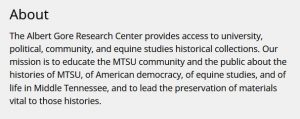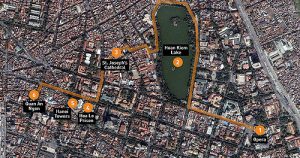This activity asked for students to experience a mobile public history site or application in the landscape for which it was created. Ironically, this is the gap my project, Nashville Sites, hopes to fill. Nashville currently has no dedicated public history site or application that is non-profit and/or educational. There are ad-driven/free apps and subscription or purchasable apps such as “City Walks” (a global company that combines corporate sponsors and advertising). Tours and entries are based on a City Walks staff “writing team” but the site also relies on crowdsourced information by users. In Nashville, there are also a few webpages that provide local history based on locations that include Google maps, but they are not particularly mobile friendly nor scholarly.
I decided therefore to use HistoryPin instead and found quite a bit. This was a great experience for me because I have only used HistoryPin once before and it was not in thinking about Digital Humanities (and long before the Nashville Sites project idea was even conceived). Therefore using HistoryPin now, with all of these other things swirling around in my head and online — was extremely helpful as I develop my educational goals and exhibit layers for Nashville Sites. Here is the area that I surveyed both digitally and physically.
The place-based techniques of HistoryPin for the downtown core and West Nashville have many different collections. Most of the Pins were private citizens and registered HistoryPin users. The majority of the Pins were photographs taken by these users and while the photographs were great there was very little text, narrative, or metadata. Still, most of the major historical sites within the geographic parameters shown on the above map were “Pinned.” The one institutional presence I saw for several instances was the Albert Gore Research Center. Pins placed by the center included not only photographs but also newspaper clippings, political cartoons, and letters.
All in all it was an eye-opening experience and activity that helped me to see what is “already out there” in terms of place-based history in Nashville. While there are no landscaped-based local public history projects, there is a thriving digital humanities/history program in nearby Murfreesboro at Middle Tennessee State University. For a look at what they are doing see below. They could be a potential partner in the long-run as I (and the MHC) work to develop Nashville Sites.
Digital Humanities at MTSU
Digital Humanities projects at Middle Tennessee State University are created with and for scholars. In addition to images and historical documents, projects include multimedia components, contextual themes, and lesson plans or essays. DH projects are a collaborative effort with content and technology experts who use a variety of digital tools including CONTENTdm, ArcGIS, StoryMaps, Drupal, Omeka and more. Click here for current projects.
I’m also fascinated with Curatescape and hope to use it within my own project. As I seek to develop Nashville Sites, I think about history based on place, I’ve found the Spokane Historical particularly inspiring as a model that is different from mallhistory.org but with many similarities.
Spokane Historical
Spokane Historical is a web and mobile platform for telling stories of Spokane and Eastern Washington. Spokane Historical is a project of the Public History program at Eastern Washington University. Spokane Historical is a free app available on your Android or iPhone smart phone or tablet.





